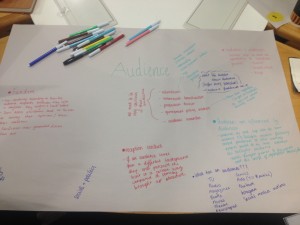Workshopping Project 4
After last weeks meeting after the lecture, it was decided that each of us would focus on various Audience related peer reviewed readings. I focused on manga and anime fandom, Georgia on fan pandering and Gracie on negative fandom.
As Georgia was ill for this prac session, Gracie and I shared our annotated bibliographies, thus gaining insights and ideas in how to present our media artefact. It was interesting to note Gracie’s researched revealed ‘three basic models of the audience; audience-as-mass, audience-as-outcome and audience-as-agent.’ (Webster, J 1998, ‘The Audience’, Journal of Broadcasting & Electronic Media, vol.42(2), pp.190-207.) The ‘audience-as-agent’ complimented my research on ‘Cosplay’ (Costume Play) which is where fans of manga and anime in Japan and now worldwide dress up as their favourite characters. Adding to this was Gracie’s other paper, ‘Intro to Fan Fiction and Slash’ (Oak, A & Ashley, J 2011, Extrapolation (pre-2012), Vol.52(1), pp.128-130) which looks at fan fiction written by women for women and their sexual relationship within narrative. This dovetails into Sarah Kornfield’s paper on Cross-cultural Cross-dressing: Japanese Graphic Novels Perform Gender in U.S., Critical Studies in Media Communication(2011) which is a also written by women for women. Interesting, is the history of gender-bender themes of men dress up as women from times of Kabuki Theatre to women dressing up as men in Cosplay. Strangely, they are known as the ‘Rotten Girls’.
Furthermore, the negative aspects of fandom are of course trolling, which Gracie has covered extensively in Bishop, J 2014, ‘Representations of ‘trolls’ in mass media communication: A review of media-texts and moral panics relating to ‘internet trolling’ and in my research Fans Behaving Badly: Anime Metafandom, Brutal Criticism, and the Intellectual Fan by authors Kathryn Dunlap and Carissa Wolf which looks at Fandam Wank – online backlash against fans that make supportive comments (and worse) about sexual violence in manga and anime.
What came up in out discussion was the idea of trying to ‘interrupt the debate’ as suggested in the assignment. What came to mind was:
- The perceptions that screen [tv, film, video] violence relates to real violence. e.g. gun violence in Hollywood movies and the high rate of gun violence in America.
- However, Japan has a lot of screen violence, including sexual violence in its manga and anime cartoons and comics but has some of the lowest crime statistics in the world.
With this in mind we discussed negatives of fandom: trolls, stalking, anonymous trolling, flaming and the positives i.e. Cosplay: one of the most popular fandom events in the world, it invites social interaction, being part of the something, a bit nerdy and it generates huge amount of money. Also, the cultural differences. In Japan, Cosplay devotees can’t wear their costumes outside but in Oz and USA they can.
With this in mind, we tried to break down what kind of artefact we would create and came to the conclusion that it might be a 10 minute documentary or a series of video interviews split between text on a website.
We assigned each other things to action:
- Russell: go to a comic store and get into contact with a Cosplay group.
- Gracie: would contact a sociologist to get the expert opinion on Cosplay and the effect of manga and anime on audiences.
Then we decided we would need to:
- Film and interview – individuals, subgroups,
- Contact someone who is in the online community
We also concluded we would need to meet with Georgia to finalise what our artefact would be.


